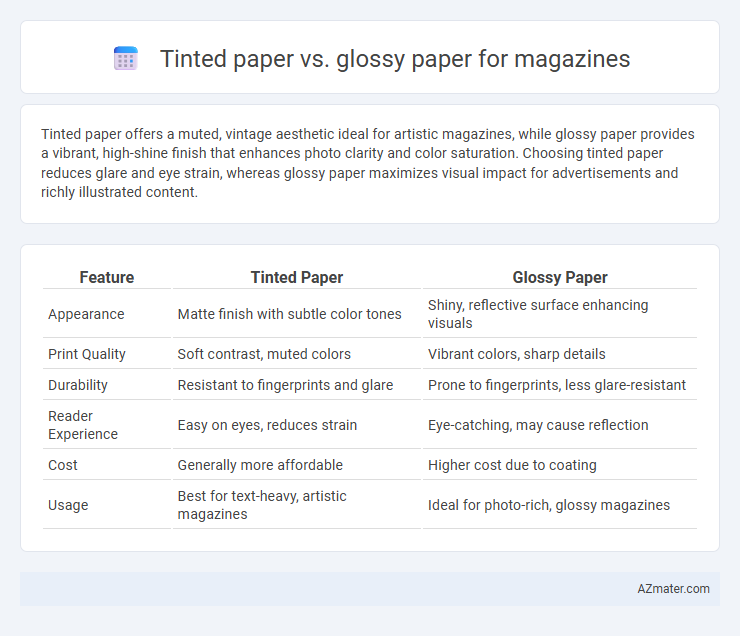Tinted paper offers a muted, vintage aesthetic ideal for artistic magazines, while glossy paper provides a vibrant, high-shine finish that enhances photo clarity and color saturation. Choosing tinted paper reduces glare and eye strain, whereas glossy paper maximizes visual impact for advertisements and richly illustrated content.
Table of Comparison
| Feature | Tinted Paper | Glossy Paper |
|---|---|---|
| Appearance | Matte finish with subtle color tones | Shiny, reflective surface enhancing visuals |
| Print Quality | Soft contrast, muted colors | Vibrant colors, sharp details |
| Durability | Resistant to fingerprints and glare | Prone to fingerprints, less glare-resistant |
| Reader Experience | Easy on eyes, reduces strain | Eye-catching, may cause reflection |
| Cost | Generally more affordable | Higher cost due to coating |
| Usage | Best for text-heavy, artistic magazines | Ideal for photo-rich, glossy magazines |
Introduction to Magazine Paper Types
Magazine paper types primarily include tinted paper and glossy paper, each offering distinct visual effects and functional qualities. Tinted paper provides a matte finish that reduces glare and enhances readability, making it ideal for text-heavy publications. Glossy paper features a shiny surface that intensifies color vibrancy and sharpness, perfect for magazines emphasizing high-quality images and advertisements.
What is Tinted Paper?
Tinted paper is a specialty printing material dyed with subtle colors to reduce glare and enhance readability in magazines, offering a softer visual impact compared to traditional white paper. It provides a unique aesthetic that can complement the magazine's design theme while masking imperfections and minimizing eye strain for readers. This type of paper is often selected to create a sophisticated or vintage look, setting the publication apart from those printed on glossy paper, which features a shiny, reflective surface that intensifies color vibrancy but may cause glare.
What is Glossy Paper?
Glossy paper is a smooth, shiny paper used for magazines that enhances color vibrancy and sharpness, making images appear more vivid and eye-catching. It has a reflective coating that provides a sleek finish, ideal for high-quality photo reproduction and visual impact. Glossy paper is often chosen for magazine covers and pages rich in graphics to attract readers with its polished aesthetic.
Visual Impact: Color and Image Reproduction
Tinted paper enhances magazine visual impact by adding a subtle hue that can create mood and complement color schemes, but it may slightly alter true color reproduction. Glossy paper offers vibrant color saturation and sharp image clarity, making photographs and illustrations appear more vivid and striking. Choosing between tinted and glossy paper involves balancing unique aesthetic effects with the need for accurate, high-contrast color representation in magazine layouts.
Reader Experience: Feel and Aesthetics
Tinted paper in magazines offers a softer, more muted visual appeal that reduces glare and provides a comfortable reading experience, enhancing readability for extended periods. Glossy paper delivers vibrant colors and sharp images, creating a striking aesthetic that captures attention with its reflective finish. The choice impacts tactile sensation, with tinted paper providing a matte texture that feels warm and inviting, while glossy paper feels slick and polished, influencing overall reader engagement.
Printing Quality and Ink Absorption
Tinted paper enhances magazine aesthetics by reducing glare and offering a softer background for text, improving reading comfort while maintaining moderate ink absorption suitable for detailed images. Glossy paper provides superior printing quality with vibrant color reproduction and sharp image clarity due to its smooth, reflective surface, but it absorbs less ink, which can lead to longer drying times and potential smudging. Selection depends on desired visual effect, with glossy paper emphasizing color brilliance and tinted paper offering subtlety and reduced eye strain.
Durability and Lifespan
Tinted paper for magazines offers enhanced durability by reducing glare and resisting fingerprints, which helps preserve print quality over time. Glossy paper provides a sleek, vibrant finish but is more susceptible to scratches, smudges, and fading due to its reflective coating. The lifespan of tinted paper generally surpasses glossy paper under frequent handling and exposure to light, making it ideal for long-lasting publications.
Cost Comparison: Tinted vs Glossy Paper
Tinted paper generally costs less than glossy paper due to its simpler manufacturing process and lower coating expenses, making it a budget-friendly option for magazine printing. Glossy paper, with its high-gloss finish and premium coatings, is more expensive but offers superior image sharpness and color vibrancy, which can justify the higher investment for high-end publications. Printing budgets often weigh the cost difference, with tinted paper reducing overall expenses while glossy paper increases production costs by 20-40% depending on paper weight and finish quality.
Environmental Considerations
Tinted paper for magazines often uses fewer chemicals and requires less energy during production compared to glossy paper, resulting in a smaller carbon footprint and reduced environmental impact. Glossy paper typically involves coatings that hinder recyclability and contribute to higher waste levels due to its plastic content. Choosing tinted paper supports sustainable publishing practices by improving biodegradability and facilitating easier recycling processes.
Choosing the Right Paper for Your Magazine
Selecting the right paper for your magazine depends on the desired aesthetic and reader experience; tinted paper offers a muted, vintage look that reduces eye strain and enhances readability for text-heavy publications. Glossy paper delivers vibrant color reproduction and sharp images, making it ideal for magazines emphasizing photography, fashion, and high-impact visuals. Consider the magazine's content, printing budget, and audience preference when choosing between tinted and glossy paper to optimize both presentation and cost-effectiveness.

Infographic: Tinted paper vs Glossy paper for Magazine
 azmater.com
azmater.com